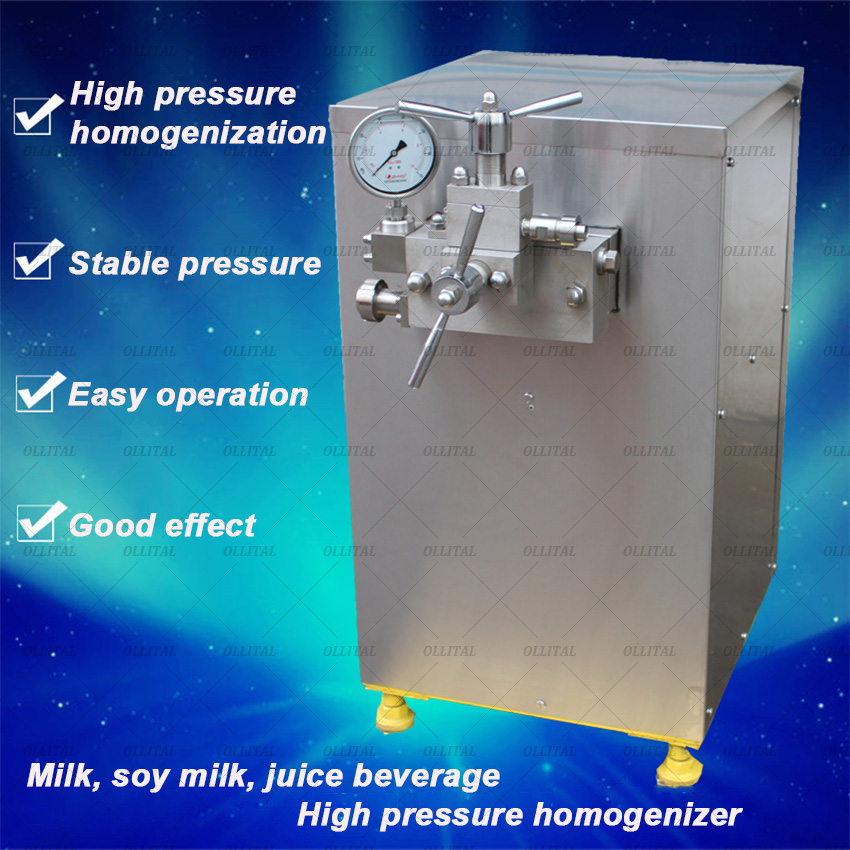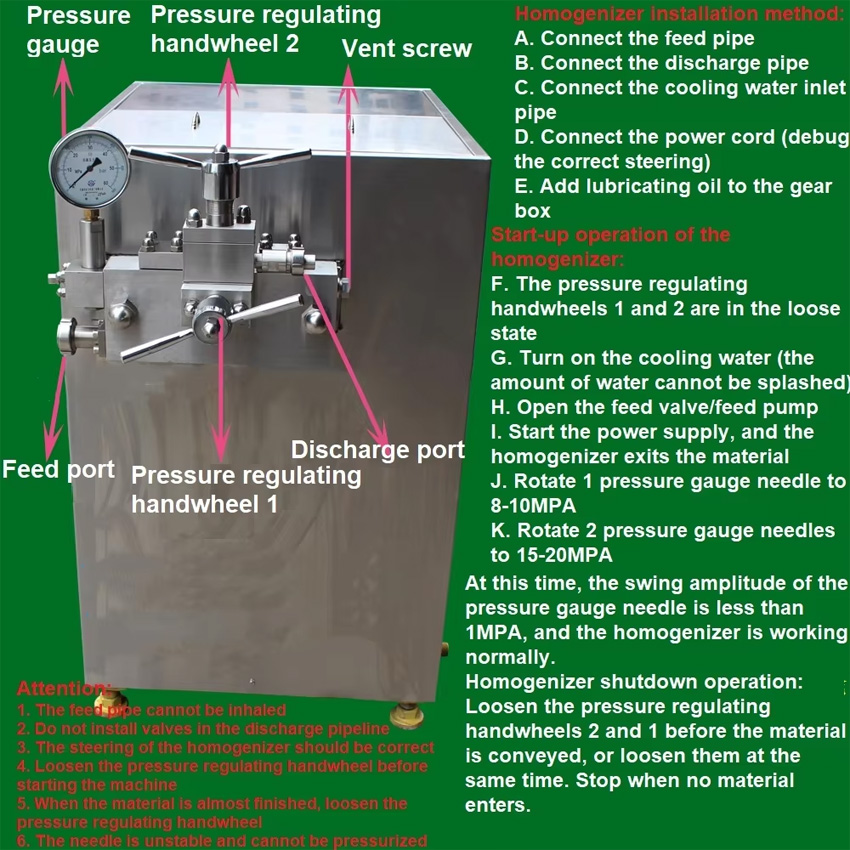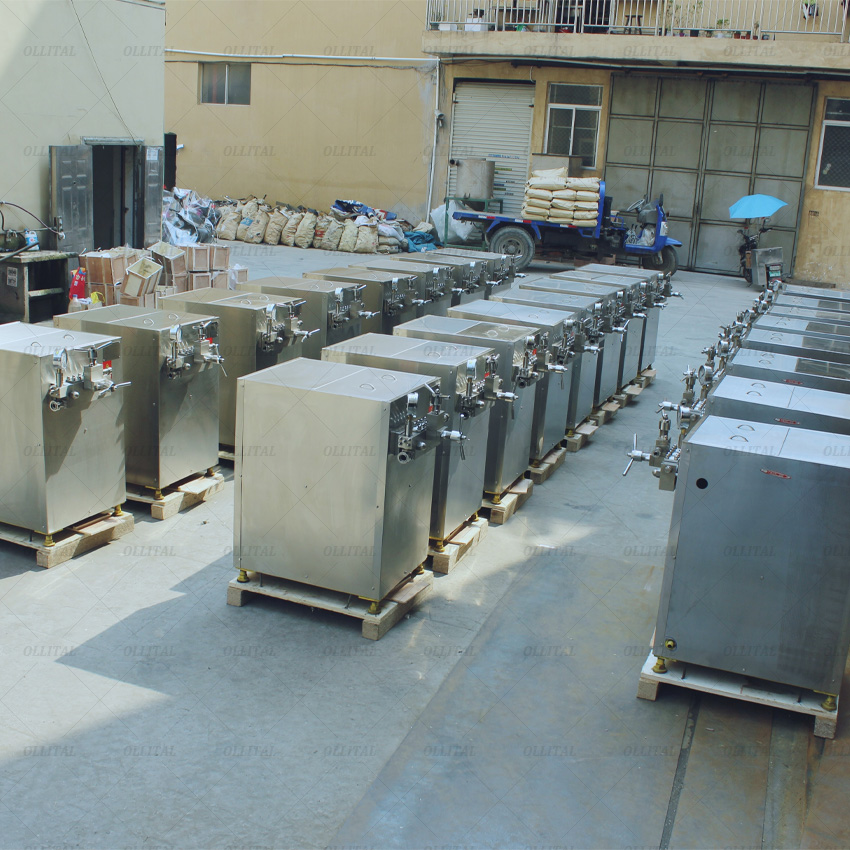Hochwertige 1,5-Liter-Labor-Sprühtrocknerausrüstung
Sprühtrockner im Labormaßstab eignen sich für die Produktion von Universitäten, Forschungsinstituten und Lebensmittel- und pharmazeutischen Chemieunternehmen.
High pressure homogenizer is a device used to treat liquids or slurries under high pressure. The purpose is to break up, disperse or emulsify solid particles or droplets in the liquid through high pressure to achieve a homogenization effect. It is widely used in food, chemical, biological and other industries, especially in the production of dairy products, beverages, biological products and cosmetics. In the food field, High pressure homogenizers play a vital role. For example, in the production process of dairy products, it can effectively remove milk skin or other impurities that may affect the taste and quality of the product. The beverage industry also benefits from this. By precisely controlling the degree of homogenization, the consistency and stability of the beverage can be adjusted to meet the taste requirements of different consumers; in the research and development and production of cosmetics, High pressure homogenizers are a powerful assistant in creating silky, smooth and easy-to-absorb emulsions. High pressure homogenizers have demonstrated their incomparable application value and importance.


The working principle
the High pressure homogenizer is to pump the liquid into a small-hole nozzle through a pump. Under the action of high pressure, the liquid is ejected at high speed through the small hole, forming extremely high shear force and impact force, breaking up large particles in the liquid to achieve a homogenizing effect. The common working pressure range is usually between 50-200 MPa, and the specific pressure is adjusted according to different application fields and needs.
The specific principle can be divided into the following steps:
Pressurization and delivery
The High pressure homogenizer delivers the material (liquid or slurry) to the homogenizing chamber through a high-pressure pump. This pump can provide pressures ranging from 50 MPa to 200 MPa or more, depending on the application requirements. After the material is fed in, the pressure accumulates in the homogenizing chamber.
Nozzle or gap acceleration
The material enters the working part of the homogenizer (usually a nozzle or a special gap). The nozzle has a very small aperture, or there is a small gap in the equipment. When the material passes through these narrow pores under high pressure, the material flow rate will increase rapidly, forming a high-speed flow.
Shear force and impact force effect
·1.Shear force: During the high-speed flow of the material, it rubs strongly with the surrounding liquid and the wall of the equipment, generating severe shear force, which helps to break up the particles or droplets in the liquid.
·2.Impact force: When the high-speed material flow passes through the homogenizing hole or nozzle, the liquid collides with other droplets or solid particles. High-speed impact causes the particles to fragment, further refining the size of the particles or droplets.
·3.Pressure difference: When the material flows from the high-pressure area to the low-pressure area, the sharp change in pressure will also cause the particles to break, thereby achieving the effect of dispersion.
Multiple treatments (circular homogenization)
Many High pressure homogenizers are designed to support multiple circulation treatments of materials. Each time the material passes through the homogenization area, it may pass through a series of different nozzles or homogenization holes, and continuously disperse and emulsify until the particles reach the predetermined fineness requirements.
Particle refinement and homogenization
After experiencing shear force, impact force and pressure changes, the particles, droplets, cell walls, etc. in the liquid are refined and evenly distributed, resulting in a more uniform and stable emulsion or suspension.Finally, the large particles, droplets or solid components in the material are dispersed to the micron or even nanometer level, and the particle distribution of the product is more uniform, which improves the stability, texture and taste of the product, especially in the food, medicine, cosmetics and other industries, and plays a very important role.
This principle is based on high pressure, fast flow and physical impact, which greatly improves the homogenization effect of liquids or suspensions.

Features of high pressure homogenizer
High-pressure homogenization equipment has good fine and dispersing capabilities, and can reduce the size of particles or droplets to micrometers or even nanometers. Improving water solubility and stability can improve the uniformity of products during emulsification and dispersion, and enhance their stability. Compared with conventional homogenizers, High pressure homogenizers have higher efficiency and lower energy consumption. High-pressure homogenization equipment is widely used in food, biology, chemical industry, cosmetics and other industrial fields due to its unique performance. The following introduces some basic characteristics of High pressure homogenizers:
High-efficiency refining effect
The High pressure homogenizer can refine particles or droplets to micrometer or even nanometer levels. Through high-pressure spraying, shearing and impact, it can effectively break particles, reduce the size of droplets or particles, and ensure the fineness and smoothness of the final product.
Strong uniformity
The equipment can evenly disperse solid matter, oil droplets, emulsions, etc. in liquid or slurry, reduce large particles or uneven areas, and ensure product stability. For industries such as dairy products, beverages and cosmetics, uniformity is the key to product quality.
Improve product stability
The High pressure homogenizer significantly improves the stability of the product through refinement and dispersion during the emulsification process. For example, the oil-water phase in emulsions and suspensions is more stable, reducing precipitation, stratification and other phenomena.
Energy-saving and high efficiency
Compared with traditional homogenization methods, High pressure homogenizers have higher efficiency. The ideal homogenization effect can be achieved in a shorter time, thus reducing energy consumption. At the same time, due to its efficient working method, it can also increase production speed.
Strong adjustability
The working pressure and flow rate of the High pressure homogenizer can usually be adjusted, and users can adjust the parameters of the equipment according to the characteristics of the material, the needs of the product and the requirements of the production process. For example, the size of the nozzle and the pressure of the booster pump can be adjusted according to the different ratios of emulsified oil and water, the requirements of particle refinement, etc.
Wide adaptability
The High pressure homogenizer can handle liquids of different viscosities and different components, whether it is low-viscosity aqueous liquids or high-viscosity suspensions and emulsions, they can be efficiently processed. It has strong adaptability to liquids and can handle various liquid materials including food, cosmetics, medicine, chemicals and other fields.
Reduce particle aggregation and precipitation
The High pressure homogenizer can prevent particles or oil droplets from aggregating or precipitating in the liquid through effective dispersion, ensuring the long-term stability of the liquid, especially in the production process of emulsions and suspensions.
Friendly to heat-sensitive materials
The High pressure homogenizer usually completes the processing in a shorter time, avoiding the need for long-term heating, so it has good adaptability to heat-sensitive materials (such as certain food ingredients, drug ingredients, etc.), and can keep their nutrients or active ingredients intact.
Multiple cycle processing (adjustable number of cycles)
Many High pressure homogenizers can process materials multiple times to further refine and homogenize them to achieve more ideal results. For example, in some very demanding emulsification or dispersion processes, multiple cycles can be used to gradually achieve the goals of refinement and stabilization.
Reducing microbial growth
In food processing or pharmaceutical processes, High pressure homogenizers can be used to reduce the number of microorganisms in the product and improve product hygiene and safety. The high pressure and mechanical energy generated during the homogenization process help inhibit the growth of bacteria or yeast.
The characteristics of High pressure homogenizers make them occupy an important position in many applications that require efficient, detailed and uniform dispersion. It can significantly improve product quality and production efficiency, and is a very indispensable equipment in many industries.

 +86 15960821529
+86 15960821529 kevin@ollital.com
kevin@ollital.com kevinollital@gmail.com
kevinollital@gmail.com +86 15960821529
+86 15960821529 +8615960821529
+8615960821529